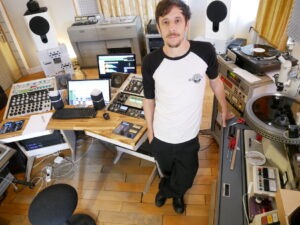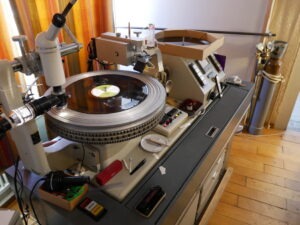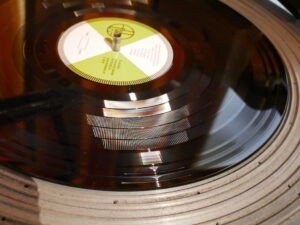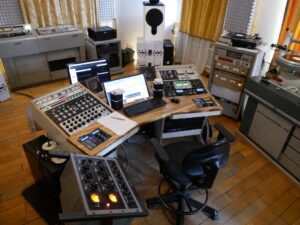Today we are taking a dive into an area of audio not as often talked about. A place that goes beyond Mastering… and beyond the digital realm. As retro as it is current, Vinyl is often an audiophile and music collector’s favorite medium to listen to their favorite songs. This is why I decided to bring a set of questions to someone who knows it best; we welcome the cutting engineer Adi Flück to the Going Deep Interview series! A role less talked about than its closest sibling the Mastering Engineer. Not only does he do Mastering, but he also cuts lacquer, which becomes the Vinyl Records you may have at home!
Before we get into the interview, here is a little history about Vinyl Records. The phonograph disc record was the primary medium used for music reproduction throughout the 20th century. It had co-existed with the phonograph cylinder from the late 1880s and had effectively superseded it by around 1912. Records retained the largest market share even when new formats such as the compact cassette were mass-marketed. By the 1980s, digital media, in the form of the compact disc, had gained a larger market share, and the record left the mainstream in 1991.[1] Since the 1990s, records continue to be manufactured and sold on a smaller scale, and during the 1990s and early 2000s were especially used by disc jockeys (DJs) and released by artists in mostly dance music genres, and listened to by a growing niche market of audiophiles. The phonograph record has made a niche resurgence as a format for rock music in the early 21st century – 9.2 million records were sold in the US in 2014, a 260% increase since 2009.[2] Likewise, sales in the UK increased five-fold from 2009 to 2014.
As for Adi, he is the main mastering and cutting engineer at Centraldubs Studios in Bern, Switzerland. Adi has been mastering and cutting records for the last fifteen years. He started his career in live music business as FOH (front of house) mixing engineer. He then toured for years internationally and was recording bands, but then he finally decided to focus completely on mastering and cutting. Some of his clients and credits are Swiss electro Godfathers YELLO and Boris Blank, electronic Techno label !K7 (Tricky, DJ Kicks series, DJ Tennis ect.), Moriarty, Altin Gün among many others.

So, without further ado, Adi Flück is here to talk all things Vinyl!
BOS: Can you tell the readers a little more in depth about what your job is as a Cutting Engineer?
ADI: My job is it to create or “cut“ aka, the master record or master lacquer that will be used in the pressing plant to make more copies. You could call it the “mother record” or “mother disc”. On the technical side we have to take care that the record is playable, per example the needle doesn’t jump, not too much distortion, ect. On the musical side we have to make it sound as good as possible or as close to the clients wishes as possible.
BOS: I always found it extremely interesting how your studio looks like a lab. Literally with microscopes and gas tanks and even lazers! Can you explain what some of these more ‘scientific element’s’ do for the cut?
ADI: Just like working with analog tape, cutting records needs specific calibration procedures. If you really want to be on top of the game with all specs, you need to check your system from time to time. You need a very matrix like audio system that allows you to check and measure every point in the system, from start to end. An example is the audio coming out of your computer (DAC – Digital Analog Conversion), what is coming out of the cutting amplifier, and what is coming back from the playback system (pick up), just to name a few. Because of this, you need quite a lot of equipment. The result: it looks a lot like a lab, because we also use a lot of the same things! The microscope is used to inspect the cut groove. The helium (tank) is used to cool the cutterhead so that the drive coils (the two coils the make the cutting stylus move) have an even as possible temperature, and the laser is actually a normal light beam. With this so-called Buchmann-Meyer Light, you can target a light source in a certain angle towards the disc and the reflecting light forms a pattern. With this pattern, you can visually determine the level that the groove has been cut. It’s kind of an old school, science-fiction dB meter. Super cool tool none-the-less.

BOS: What makes Vinyl ‘analog’ vs something such as a CD being ‘digital’? What’s the difference and why do they sound different?
ADI: Well, Vinyl is played back with an analog system. The Music is stored in mechanical grooves instead of digital, like CD. With Vinyl there is more distortion that’s pleasing to the human ear (up to some extent). Also, all the bad specs of Vinyl are more close to the real world hearing than digital is. Signal to noise ratio of around 40 dBs and Left Right channel separation of 30dBs is ways closer to your ‘human hearing’ than the same specs for digital/CD. All-in-all, the sound of vinyl is more touching and organic, as long as it is well done.
But, alas, it could also feel different because it’s fun to look at the disc turning while its playing!
BOS: Along with this same topic; Vinyl records are said to sound ‘warmer’, can you explain why this is? Do they really “sound better”? Or do they just sound “different”?
ADI: Hmm, it definitely sounds different. The question is what is better? Is it that you measure can it with linearity and noise level, or is it that you listen and go like “wow, I just like this better.” I think at the end of the day, a person has to understand that humanity often tries to go after specs and details; but bottom line is you want to listen to music that makes you feel good, and you might even want to dance to. No matter the medium. But to leave the philosophical part and get back to your question about it sounding ‘different’; yes, 9 out of 10 times you will like the vinyl version better than the digital version, mainly because of the ‘organic and natural to the human ear’ result. 
BOS: What is a super simplified step-by-step process that music goes through to get to a vinyl record you see at the shop?
ADI: First you etch or „cut „ this continues groove into a Lauer or copper (DMM – Direct Metal Mastering) disc. This Master records then gets sprayed with silver dust to give it an electrically conducting surface. Then from here, it gets galvanized, which means that through electroplating nickel, it gets plated to the silver surface. After there is enough nickel plated to the disc, you can remove the metal negative or stamper from the Masterdisc, and you can use that metal piece for pressing. Lastly, a warm vinyl puck is set between the stamper for A and B side and the pressing machine does the rest. That’s the short version. It also helps to understand if you watch one of many videos on youtube. Such as this one: Watch How They Make Vinyl Records Here
BOS: As many know, there is a big vinyl boom that’s been going on for a few years now. Why do you think this is?
ADI: In my opinion there are many reasons. One is an economical one, since CDs are gone (or at least, not as relevant as they once were), bands need a something to sell at their shows or online that the fan can physically have. Of course, there is also the aspect of a real record, everybody can release something digital nowadays, but a record has something serious to it. Another thing to consider is that many famous musicians and groups pushed the hype, everybody thought its cool to do it again after this. And last, but not least, is the sound and the physical music aspect. There are still millions of books sold every year, right? So, the nice things in life we might just want to touch and feel. It’s kind of like our loved ones…
BOS: What’s the importance of using a cutting engineer before sending directly to a plant?
ADI: Well, a cutting engineer is very experienced and has a great studio environment and knows about styles, genres and cares about your production when it comes to vinyl. He wants your record to sound awesome, and not just an ok or easiest fool-proof way to duplicate the record. We do have great tools to correct issues before it ever gets to the plant. The cutting engineer is easily the most important part of the process if you want the best quality. You can also discuss your release beforehand and he will call you if something isn’t right. If the plant is cutting your master you never really know who is cutting it where with what equipment. So, you have much less control over your production and quality. I guess it’s a bit the same as if you would send your mixes to someone random to master it at a CD manufacturing plant, then they press CDs from that, I mean good luck with that approach! That could end up scary. 
BOS: What is the difference between a DMM cut (Direct Metal Mastering) and a Lacquer cut?
ADI: The difference lies the material of the blank disc (Lacquer versus Copper surface) the master disc is being made from. DMM has been developed in the 80s, you have less surface noise, so it’s good for very dynamic material like classical music. Also, its more linear and has less pre echo (hearing the music before the tune begins). That also is good for Classical music and maybe music that needs to be super clean. In my opinion DMM can sound good with the right music and the right system calibrations.
But for the most music, like rock, hip-hop, electronic, Jazz, acoustic, world, country ect. a well-done lacquer master is superior (to my ears). Especially for loud and bassy maxis and 7“. With these you get more of that extra magic mojo, a bit like from tape; it just adds something that is irresistible. If you are living in North America, you don’t have to worry about DMM. the only two machines (out of 22 total made) are based at the Scientology headquarters I believe, somewhere in California. So, as long as you are not best friends with Tom Cruise, you will not get your dirty beats or fuzzed guitars cut on to copper, hah! But, here in Europe, most of the plants own a DDM machine, so here it’s more likely to get it cut to DMM.
BOS: When you are cutting a record, what are you looking for in the mix down or master to be sure it’s a great cut?
ADI: It has to sound good. No seriously, it’s that simple. But to achieve this, leave the brick wall limiter a bit away. make music compact with compression in the right way, tape saturation and such, it all works. Don’t use the Brickwall to gain a lot of loudness and ‘slam it’.
Be careful with a lot of distortion of course, such as using clipping and exciters. Since vinyl also adds distortion, this can sound dirty very quick. There is not much a cutter can do about if it’s too dirty at that point. Best practice is to master with a professional engineer, and tell him/her about your vinyl release and then make sure to send your master to a Cutting engineer that is nearby and that you can trust. Send him the 24 bit version of the masters, it will maybe have one limiter and another backed off about 1-2 dBs, so he can choose what works best for the cut.
BOS: In today’s world of ‘loud mastering’, what is your take on loudness when it comes to vinyl? And what about Digital since you are also a Mastering Engineer?
ADI: It really depends on the music and style and the production. I would go with around 8dBs RMS, but it really depends on the style and instrumentation of the music. Less than 6dBs rms/lufs for vinyl will almost always not sound very good. Too much dynamics on the other hand can also be problematic for the cut, especially if you have long-length sides to cut. The more length of music to a vinyl’s side, the less loud a cut can be – the louder the cut, the more space you need. But something really important I have learned over the years is to give the music a good vibe and make it as approachable as possible. Try to make people move with your music, and the record will too. No volume or loudness will make you famous.
BOS: Do you look for differences in genre for the cut, or is it more-so just to do with the song’s frequencies and overall master for the cut? What I mean is; do you cut jazz differently than let’s say, a rock song?
ADI: It also really depends here. Every caring cutter is doing a test cut to see how it sounds played back with a pick up system. When he does this, he is looking for the genre feel, and overall loudness of the record. It’s more about how loud can you cut the disc without too much distortion and keep it sounding musical for that style.
BOS: Let’s talk about material. This is something that is rarely heard of these days in audio. Actual, physical, hand held material, which is used to make the lacquers. As many know, one of the biggest lacquer (material) factories (Apollo Masters) in the world just went up in flames, which is so very sad. How has this affected the vinyl/cutting industry? Have you noticed any difference yet in Europe?
 ADI: Europe seems to be alright in this regard, so far, since almost all of mainland cutters were using the Japanese blanks MDC. The supply chain from japan seems to be working for now. But there is another player called Corona (Covid19) that is playing it’s game on the industry.
ADI: Europe seems to be alright in this regard, so far, since almost all of mainland cutters were using the Japanese blanks MDC. The supply chain from japan seems to be working for now. But there is another player called Corona (Covid19) that is playing it’s game on the industry.
It’s all stable, but like it is right now for many of us, nobody knows what happens next and what it will be like in 2 months. It seems like the North American industry will be much more affected by the loss of Apollo master discs, and Corona. But, it’s hard to get an accurate grasp at this point.
I hope that there is a new brand of discs on the market by the end of the year, and the supplies for everyone will be covered again. You can learn about the Apollo Masters fire, Read About The Apollo Masters Fire Here.
BOS: Many people have heard of Dub plates. What is the different with a Dub Plate vs a Record they can buy at the store?
ADI: A Dubplate is actually a master quality cut. We use the same acetate discs as used for the masters. But, instead of sending it to the pressing plant, the customer uses the disc to be played at the club, at home or wherever. It’s just one piece instead of main copies. Usually Djs use it to play their unreleased tunes, for instance. Or you can have your album cut as a reference master with the same sound before cutting the actual masters. So, if you want to know how your music sounds on Vinyl, there is always this option of getting a Reference master disc (or dub plate) before you cut and press the real one.
BOS: Where do you see the vinyl industry going in the future?
ADI: No clue, at all. This can go anywhere. But somehow I have a feeling that vinyl will stay as a niche product for quite some time. Maybe for another 10, 20 years easily, and then after that you will probably be able to print your favorite bands LP at home with a 3D printer or personal ‘lathe’.
But who knows, maybe Cassette tapes will take over the world and streaming will slowly disappear, we can only guess with the way the industry turns.
There you have it! Huge thanks to Adi for this awesome insight! I hope some of you reading this have learned more about the vinyl industry and music industry as a whole. There are so many hidden jobs that go into music being released, and cutting engineering is just one of them. Keep checking back for future “Going Deep” articles to discover some of the other less-known arts in the music business! You can read more about Adi here and contact him about any Vinyl related questions: https://www.centraldubs.com/
